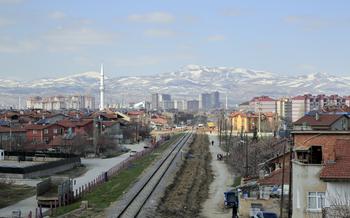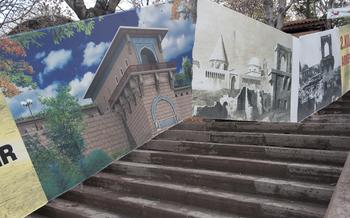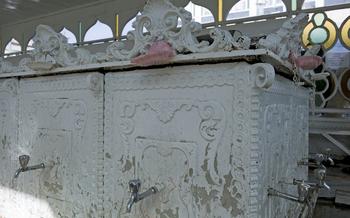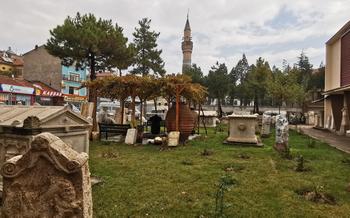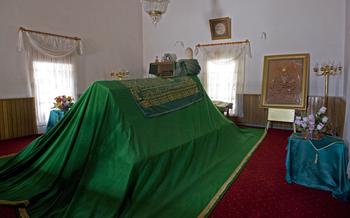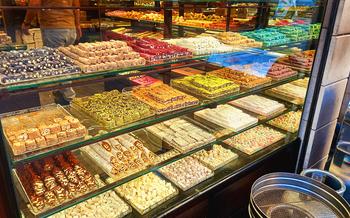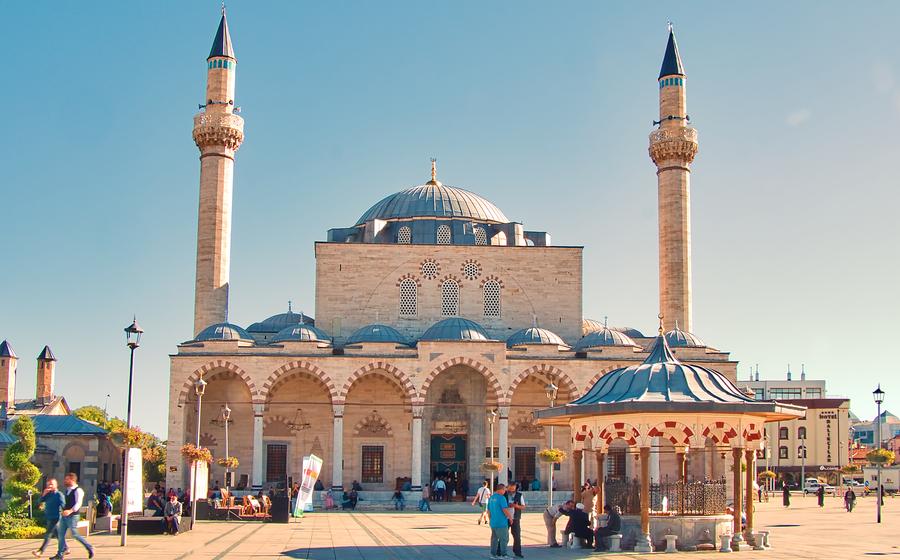
Hadji Veyiszade Mosque
- The Hadji Veyiszade Mosque: A Spiritual Haven
- Stepping into the Past: The Mosque's History
- A Blend of Architectural Styles: The Mosque's Design
- A Place of Worship and Community: The Mosque's Role
- A Journey Through Time: The Mosque's Museum
- In the Heart of Konya: The Mosque's Location
- A Symbol of Faith: The Mosque's Minarets
- Preserving the Past: The Mosque's Restoration
- A Place of Reflection: The Mosque's Courtyard
- A Masterpiece of Tilework: The Mosque's Interior
- A Center of Learning: The Mosque's Madrasa
- A Place of Pilgrimage: The Mosque's Significance
- In the Footsteps of Rumi: Exploring Konya
- Insider Tip: Unveiling the Hidden Gem
The Hadji Veyiszade Mosque: A Spiritual Haven
The Hadji Veyiszade Mosque, a prominent architectural gem in Konya, Turkey, stands as a testament to the city's rich cultural heritage. Built in the 13th century, the mosque holds a special place in the hearts of Konya's inhabitants and visitors alike. Its captivating blend of Seljuk and Ottoman architectural styles, coupled with its profound historical significance, makes it a sacred and revered destination.
The mosque's construction was commissioned by Hadji Veyiszade, a wealthy merchant who sought to establish a spiritual sanctuary for the local Muslim community. Over the centuries, the mosque has undergone several renovations and expansions, each contributing to its architectural evolution. Today, it stands as a magnificent example of Islamic architecture, beckoning visitors to immerse themselves in its spiritual ambiance and historical charm.
Beyond its religious significance, the Hadji Veyiszade Mosque serves as a vibrant community center, hosting a range of social and religious gatherings. It is not uncommon to witness locals engaging in lively discussions, sharing stories, or simply seeking solace within the mosque's serene surroundings. The mosque's involvement in educational initiatives and charitable activities further underscores its commitment to fostering a strong and cohesive community.
Stepping into the Past: The Mosque's History
The Hadji Veyiszade Mosque stands as a testament to the rich history and architectural heritage of Konya. Its construction dates back to the 13th century, during the reign of the Seljuk Sultanate, when Hadji Veyiszade, a wealthy merchant and philanthropist, commissioned its construction. The mosque's initial design showcased the architectural style prevalent during the Seljuk era, characterized by its simplicity and lack of ornamentation.
Over the centuries, the mosque underwent several renovations and expansions, reflecting the changing architectural styles and the evolving needs of the community. In the 16th century, during the Ottoman period, the mosque was significantly expanded and modified. The Ottomans added a new prayer hall, a courtyard, and a madrasa, or Islamic school, to the complex, blending Seljuk and Ottoman architectural elements.
In the 19th century, the mosque underwent a major restoration, which aimed to preserve its historical integrity while adapting it to modern requirements. This restoration involved repairing structural damage, restoring the original tilework, and adding new features such as a library and a museum.
Today, the Hadji Veyiszade Mosque stands as a historical monument, protected by the Turkish government. It continues to serve as a place of worship for Muslims and a cultural landmark for visitors from around the world, offering a glimpse into the rich history and architectural heritage of Konya.
A Blend of Architectural Styles: The Mosque's Design
The Hadji Veyiszade Mosque showcases a harmonious blend of Seljuk and Ottoman architectural styles, reflecting the rich history and cultural influences of Konya. The mosque's dome, a prominent feature, is a classic example of Seljuk architecture, characterized by its bulbous shape and intricate tilework. The minaret, on the other hand, exhibits Ottoman influence with its slender design and multiple balconies.
The interior of the mosque is adorned with exquisite tilework and calligraphy, showcasing the craftsmanship and artistry of Islamic art. The intricate patterns and vibrant colors create a visually stunning atmosphere that captivates visitors. The courtyard, a serene space within the mosque, features a central fountain and is surrounded by elegant arches and columns, providing a tranquil setting for contemplation and reflection.
A Place of Worship and Community: The Mosque's Role
The Hadji Veyiszade Mosque serves as a central place of worship for Muslims in Konya. It is a place where believers come together to offer prayers, seek spiritual guidance, and connect with their faith. The mosque's serene atmosphere and beautiful architecture create a conducive environment for contemplation and devotion.
Beyond its religious significance, the mosque also plays a vital role as a community center. It serves as a gathering place for social and religious events, fostering a sense of unity and belonging among the local Muslim community. The mosque's courtyard and other facilities are used for various community activities, such as religious classes, lectures, and charitable events.
The mosque's involvement in educational and charitable activities further strengthens its role as a community hub. It supports local schools and madrasas, providing education and religious instruction to young students. The mosque also engages in charitable work, offering assistance to those in need and promoting social welfare within the community.
Moreover, the mosque serves as an important institution for preserving Islamic traditions and culture. It hosts cultural events, workshops, and exhibitions that showcase Islamic art, music, and literature. Through these initiatives, the mosque plays a crucial role in transmitting Islamic heritage to future generations and promoting interfaith understanding and dialogue.
A Journey Through Time: The Mosque's Museum
The Hadji Veyiszade Mosque boasts a remarkable museum that houses a treasure trove of artifacts and exhibits showcasing the mosque's rich history and significance. Step into this museum, and you'll embark on a journey through time, delving into the mosque's past and the Islamic culture that surrounds it.
The museum's exhibits are carefully curated, providing visitors with an immersive experience. You'll find ancient manuscripts, intricate calligraphy, and rare artifacts that tell the story of the mosque's construction, its evolution over the centuries, and its role in the local community.
One of the highlights of the museum is its collection of Islamic art. Admire the delicate tilework, intricate carvings, and colorful mosaics that adorn the mosque's interior. Learn about the symbolism and craftsmanship behind these artistic masterpieces, and gain a deeper appreciation for Islamic art and architecture.
The museum also sheds light on the mosque's role as a center of learning and scholarship. Discover the history of the mosque's madrasa, or Islamic school, and its contribution to religious education in the region. Learn about the scholars and students who studied within these walls, and the impact they had on Islamic thought and culture.
Through its exhibits and artifacts, the Hadji Veyiszade Mosque's museum offers visitors a unique opportunity to explore the mosque's heritage, delve into Islamic art and culture, and gain a deeper understanding of the mosque's significance in the history of Konya.
In the Heart of Konya: The Mosque's Location
The Hadji Veyiszade Mosque enjoys a prime location in the heart of Konya, Turkey. Situated in the city's historic center, the mosque is within easy reach of numerous other historical sites and attractions. The iconic Mevlana Museum, dedicated to the renowned poet and mystic Rumi, is just a short walk away. Visitors can also explore the Alaeddin Mosque, the Sille Village, and the Konya Archaeological Museum, all located in close proximity to the Hadji Veyiszade Mosque.
The mosque's central location makes it easily accessible by public transportation. Several bus lines stop near the mosque, providing convenient connections to different parts of the city. Taxis and rental cars are also readily available for those who prefer private transportation.
For visitors seeking a comfortable stay, a range of accommodation options is available in the vicinity of the mosque. From budget-friendly guesthouses to luxurious hotels, there are choices to suit every preference and budget. Dining options are equally diverse, with traditional Turkish restaurants, international cuisine, and cozy cafes scattered around the area.
A Symbol of Faith: The Mosque's Minarets
The Hadji Veyiszade Mosque boasts four towering minarets that stand as symbols of faith and architectural prowess. These minarets, reaching towards the heavens, are not only aesthetically pleasing but also hold significant religious and cultural importance.
The minarets serve as a call to prayer for the Muslim community. From their lofty heights, the muezzin's voice reverberates through the city, summoning the faithful to gather for prayer. The minarets' unique design and intricate tilework reflect the mosque's architectural heritage and contribute to its overall grandeur.
In addition to their religious function, the minarets also offer panoramic views of Konya. Visitors can ascend the minarets' spiral staircases to reach viewing platforms that provide breathtaking vistas of the city and its surroundings. From these vantage points, one can witness the urban tapestry of Konya, with its historical landmarks, bustling markets, and verdant landscapes.
Preserving the Past: The Mosque's Restoration
The Hadji Veyiszade Mosque has undergone several restoration and renovation projects throughout its history to preserve its historical integrity and architectural beauty. These projects have been meticulously carried out with the utmost respect for the mosque's original design and materials.
One of the most significant restoration projects was undertaken in the late 20th century, which involved the repair and strengthening of the mosque's foundation, as well as the restoration of its intricate tilework and calligraphy. Local artisans and craftsmen played a crucial role in this process, using traditional techniques and materials to ensure the authenticity of the restoration.
The mosque's courtyard has also been restored to its former glory, with the repair of its stone pavement, the restoration of its water features, and the replanting of its lush gardens. These efforts have not only preserved the mosque's historical character but have also enhanced its functionality and appeal to visitors.
The restoration of the Hadji Veyiszade Mosque serves as a testament to the community's commitment to preserving its cultural heritage. By carefully restoring and maintaining this architectural masterpiece, future generations will continue to appreciate its beauty and significance for years to come.
A Place of Reflection: The Mosque's Courtyard
The Hadji Veyiszade Mosque boasts a spacious courtyard that exudes an atmosphere of serenity and tranquility. This outdoor space serves multiple functions, contributing to the mosque's overall significance.
The courtyard plays a crucial role in facilitating ablutions, the ritual cleansing performed by Muslims before prayer. Ablution fountains are strategically placed within the courtyard, allowing worshippers to purify themselves before entering the prayer hall.
Beyond its practical function, the courtyard also serves as a gathering space for community events and social interactions. During religious festivals and celebrations, the courtyard transforms into a lively venue for communal gatherings, fostering a sense of unity and camaraderie among the faithful.
The courtyard's landscaping contributes to its serene ambiance. Lush greenery, colorful flowers, and neatly trimmed trees create a visually appealing environment that enhances the overall aesthetic of the mosque. The courtyard's natural beauty provides a soothing backdrop for contemplation and reflection, inviting visitors to pause and appreciate the tranquility of the surroundings.
A Masterpiece of Tilework: The Mosque's Interior
The interior of the Hadji Veyiszade Mosque is a testament to the exquisite craftsmanship and artistry of the Seljuk and Ottoman periods. The walls and domes are adorned with intricate tilework that showcase a mesmerizing array of colors, patterns, and designs. The tiles, meticulously hand-painted and arranged, create a symphony of visual harmony that is both awe-inspiring and enchanting.
The tilework depicts various motifs and scenes from Islamic art, including geometric patterns, floral designs, and verses from the Quran. The vibrant blues, greens, and reds of the tiles create a captivating effect, transforming the mosque's interior into a kaleidoscope of color. The intricate patterns and designs symbolize the unity and diversity of the Islamic world, reflecting the mosque's role as a center of worship and community.
The tilework also serves a practical purpose, helping to regulate the temperature inside the mosque. The tiles' glazed surfaces reflect sunlight, keeping the interior cool and comfortable during the hot summer months. Additionally, the tiles' intricate designs create a sense of depth and spaciousness, making the mosque's interior feel larger and more inviting.
The tilework of the Hadji Veyiszade Mosque has been meticulously restored and preserved, ensuring that its beauty and significance will continue to be appreciated by generations to come. Visitors to the mosque can marvel at the intricate details and craftsmanship of the tiles, gaining a deeper appreciation for the artistic and cultural heritage of Turkey.
A Center of Learning: The Mosque's Madrasa
The Hadji Veyiszade Mosque boasts a madrasa, an Islamic school dedicated to educating students in Islamic studies. This madrasa holds a significant place in the mosque's history, serving as a center of learning and scholarship. Here, students immersed themselves in the study of the Quran, Hadith, Islamic law, and other religious subjects. The madrasa provided a rigorous education, nurturing the minds of young Muslims and preparing them for roles as religious leaders, scholars, and community members.
Originally constructed alongside the mosque, the madrasa has undergone renovations and expansions over the centuries to accommodate the growing number of students. Its spacious classrooms and serene atmosphere created an ideal environment for learning and contemplation. The madrasa's curriculum was comprehensive, covering various aspects of Islamic knowledge, including theology, philosophy, history, and literature.
Today, the madrasa's legacy continues as it serves as a cultural center, hosting lectures, workshops, and exhibitions related to Islamic art, history, and culture. Visitors to the mosque can explore the madrasa's beautifully preserved architecture and learn about its rich history as a center of Islamic education.
A Place of Pilgrimage: The Mosque's Significance
The Hadji Veyiszade Mosque holds a profound significance in the Islamic world, attracting pilgrims from far and wide. Its status as a pilgrimage site stems from its historical and religious importance.
For centuries, Muslims have revered the mosque as a sacred place, associated with the teachings and legacy of the renowned Islamic scholar and mystic, Shams Tabrizi. Tabrizi was a close friend and mentor to the celebrated poet and Sufi master, Rumi, whose mausoleum is located nearby.
Pilgrims visit the Hadji Veyiszade Mosque to pay homage to Tabrizi and seek spiritual enlightenment. They offer prayers, recite verses from the Quran, and engage in contemplative reflection within the mosque's serene atmosphere.
The mosque's significance as a pilgrimage site has contributed to Konya's reputation as a prominent center of Islamic learning and spirituality. The city attracts a diverse mix of pilgrims and visitors, eager to explore its rich cultural and religious heritage.
The Hadji Veyiszade Mosque serves as a living testament to the enduring power of faith and the profound impact of Islamic traditions on the region. Its status as a pilgrimage site reinforces its role as a symbol of Islamic unity and a beacon of spiritual guidance for Muslims worldwide.
In the Footsteps of Rumi: Exploring Konya
The Hadji Veyiszade Mosque holds a special significance for followers of the renowned poet Rumi, whose influence is deeply intertwined with the city of Konya. As the home of Rumi's Mevlana Order, Konya attracts pilgrims and visitors from around the world who seek to explore the legacy of this spiritual master.
Beyond the Hadji Veyiszade Mosque, Konya offers a wealth of Rumi-related sites that provide a deeper understanding of his life and teachings. Visitors can delve into the Mevlana Museum, housed within the Mevlana Cultural Center, which showcases Rumi's manuscripts, personal belongings, and artifacts related to the Mevlevi Order.
Another must-visit site is the Mevlana Tomb, where Rumi's remains are laid to rest. The tomb is a sacred site for followers of Sufism and a place of pilgrimage for those seeking spiritual guidance. The tomb complex also includes a museum dedicated to Rumi's life and works.
By exploring these Rumi-related sites in Konya, visitors gain a deeper appreciation for the poet's profound impact on Islamic mysticism and literature. Konya becomes a living testament to Rumi's legacy, inviting travelers to embark on a journey of spiritual exploration and enlightenment.
Insider Tip: Unveiling the Hidden Gem
Amidst the grandeur of the Hadji Veyiszade Mosque, there lies a hidden gem that often goes unnoticed by visitors. This hidden treasure is a small, unassuming room located near the mosque's entrance. While its exterior may seem ordinary, stepping inside reveals a world of intricate tilework, vibrant colors, and historical significance.
The room served as a treasury during the mosque's early years, safeguarding precious donations and offerings made by the faithful. Its walls are adorned with exquisite tilework depicting scenes from Islamic history and tradition. The tiles, with their vibrant hues and intricate patterns, tell stories of prophets, battles, and miracles.
This hidden room is a testament to the mosque's rich history and the devotion of its builders. It offers a glimpse into the mosque's financial and administrative practices, as well as the artistic and cultural influences that shaped its design.
To find this hidden gem, visitors should look for a small, inconspicuous door near the mosque's main entrance. Once inside, they will be greeted by a breathtaking display of Islamic art and architecture. The room is a quiet and contemplative space, inviting visitors to pause and reflect on the mosque's history and significance.
Unveiling this hidden gem is a unique and enriching experience that provides visitors with a deeper understanding of the Hadji Veyiszade Mosque and its role in the history and culture of Konya.

